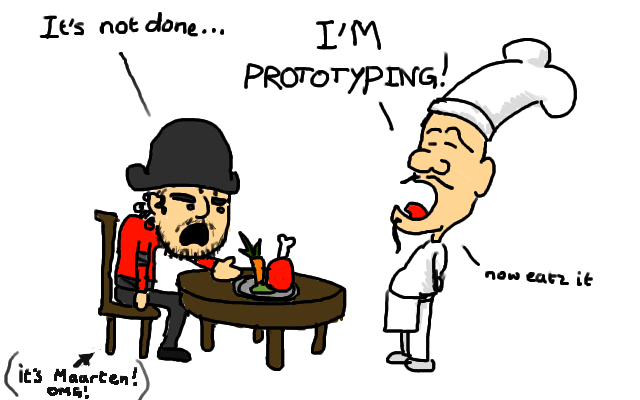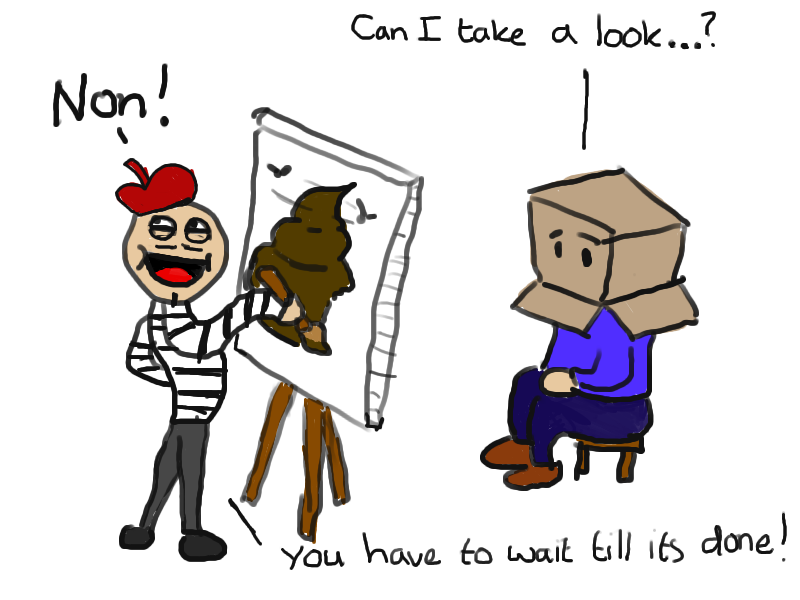Game Design: Paper Prototype
So all this time you’ve been reading our blog, watch us bump into different kind of problems and seeing our progress. But you probably have no idea what we’re actually making! Yeah, sure, something with a planet, giants and purdy pictures. Well, we still can’t tell much about the game. You know, buzz is everything, play your cards wisely, bladibladibla. Greg Kasavin from Supergiant games (from Bastion) also said that: “…we feel that games that aren’t ready to be played aren’t ready to be showed. And we here at Martian Flytrap tend to agree with that!
But if you want to experience the core thought of the game, without all of the depth, sugar coating and pretty graphics, you can play it right now!
Every sane gamedesigner prototypes his game. Sometimes this can be fairly easy. Games based on simple rules and actions are very prototypable, since the rules are easy to tweak. Sometimes, it’s better to prototype on paper instead of programming it. A good example I encountered in Jesse Schell’s “the Art of Gamedesign” was a tetris paper-prototype. It just used cardboard cut outs where one player draws them at random and slides them down, while you try to find the right place and rotation for them. If you score a row, you just pause the game and cut of the row with a knife. Sure, it’s not tetris as it should be, but it involves a lot of core elements that can be testen. The puzzling aspect is there, the time limit is there and the point system is there. It gives the game designer a pretty good view of what is fun and what is boring.

Well, our game is pretty complicated on the inside, so at first, I thought paper prototyping was impossible for us. But, of course, I was wrong. See, the rules can be complicated, the underlying experience is likely to be remarkably simple. It doesn’t have to have all the fancy-smanchy abilities and actions the real game is going to have, to give valuable information about your game. So here is one of our paper prototypes!
SUPERGIANTDICER
required:
- 7 d6’s (that is geekspeak for seven 6-sided dice)
- Pen and paper
- minimal math skills
How to play:
The player starts out with 1 d6. The goal of the game is to accumulate all your dice throws up until 120. If you reach 120 in 20 turns, you win. If you reach 120 in 15 turns, you rule. But there are 2 catches. Also, you must end the game with at least 5 dice. The player can buy new dices from his score. Like, if he has a score of 10, he can lower his score to 6 to buy a second d6. The prices of each dice is:
- die 2: 4 points
- die 3: 10 points
- die 4: 17 points
- die 5: 24 points
- die 6: 30 points
- die 7: 36 points
The other catch is that you can’t roll to high. If you roll to high, you burst. If you burst once, you have to hand in one d6 after you rolled 2 more times. If you burst twice in a row, you have to hand in two d6, but after 1 more roll. If you burst three times in a row, you have to hand in 3 d6’s directly. These effects override each other and don’t stack. You can’t have less than 1 d6. The burst values are:
- 1 die: no burst
- 2 dice: 11 or higher
- 3 dice: 15 or higher
- 4 dice: 18 or higher
- 5 dice: 20 or higher
- 6 dice: 22 or higher
- 7 dice: 24 or higher
Additionally, you can roll with less dices than you’re allowed. For example, you have 6 dices but you decide to roll with only 4 to play it safe. You can’t finish the game if you would have to hand in a die after you got a score of 120, and this would take your total amount of dice below 5. So you can finish the game with a double burst and 7 dice, but you can’t finish the game with a single burst and 5 dice.
The use of this prototype
So this prototype looks kind of silly and has nothing to do with a planet, giants or anything like that whatsoever. But in it’s core, it uses some important aspects of our game. The way the player decides the pace is a good example. We found out that a player enjoyed thinking about whether or not they should buy the next die, since more is not necessarily better. The burst is also an aspect which is in our game, where the player start risking “playing too good” and has to hand in progression speed rate (but not progression itself!). The way how people react to bursting more than once was also valuable to see if a certain aspect of the game was fun.
Of course, in our game you won’t be throwing dice to determine your score. And this does only test some of our core elements. But it’s a good place to start while Bas keeps messing around with the engine. Remember, there is always something the game designer can test or evaluate!



blog comments powered by Disqus